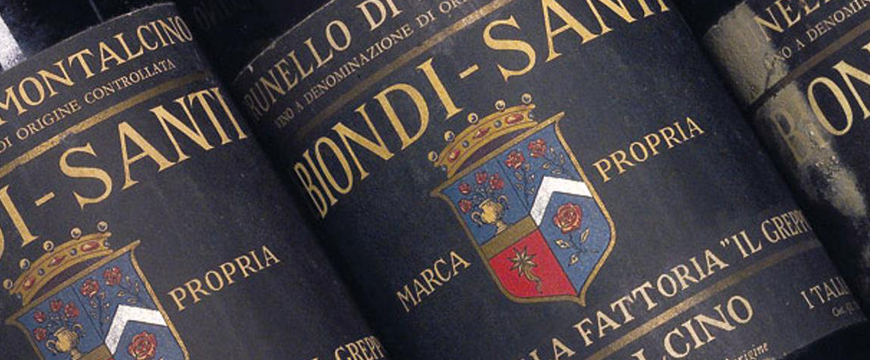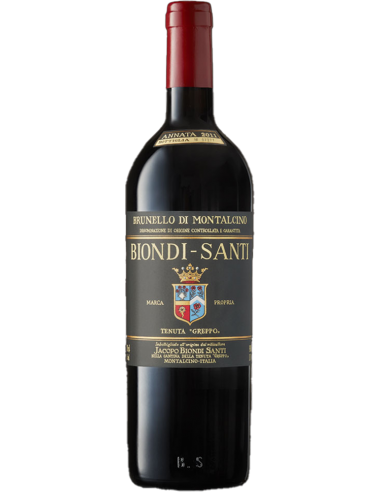-
All Products
TypeWineriesItalyRest of the WorldGreat Wines
- Barolo and its Crus
- Bolgheri
- Bordeaux and the French Bordelais
- Brunello di Montalcino iconic
- Chianti ancient tradition
- Supertuscan the Italian Bordeaux blend
- Syrah Millenary Tradition
- Great International Red Wines
- Great International White Wines
- Amarone in all its elegance
- Pinot Noir from the World
- Timorasso a jewel to discover
-
PROMOTIONS
PromotionsPromotions
-
Red Wines
ITALY Top Selection Red WinesWORLD Top Selection Red Wines
-
White Wines
ITALY Top Selection White WinesWORLD Top Selection White Wines
-
Rosé Wines
ITALY Top Selection Rosè WinesFRANCE Top Selection Rosè WinesWORLD Top Selection Rosè Wines
-
Sparkling
ChampagneItalian Sparkling WinesEnglish Sparkling Wines
- Other Wines
-
Spirits
Whiskey
-
Selections
Great Wines: focus onRare and Iconic WinesHeroic WinesWines to DiscoverAccessories
- Wine Makers
- .
Brunello di Montalcino 2011 by Biondi Santi represents an icon of winemaking tradition. It was produced with the Sangiovese Grosso clone BBS11, identified and selected by Biondi-Santi at Tenuta Greppo in the 1970s. For this Brunello, grapes from vineyards aged between 10 and 25 years were used. It is aged for 3 years in Slavonian oak barrels. It was able to benefit from a long refinement in the bottle. A warm and enveloping vintage, the bouquet is an enchanting blend of generous fruity and floral notes, including hints of black cherry, blood orange and wild flowers. The muscular but elegant structure is characterized by a beautiful savory freshness and silky tannins that lead to a warm and persistent finish. Longevity: 20-40 years.
- Product Category
- Red Wine
- Designation
- Brunello di Montalcino DOCG
- Grape / Raw material
- sangiovese
- Vintage or Cuvée
- 2011
- Size
- 750 ml.
- Country
- Italy
- Region
- IT - Tuscany
- Alcohol Content
- 13.5% vol.
- Service Temperature
- 16° – 18° C.
- Suggested Glass
- Tulip glass very large
- Special Features
- Historical Vintages
- Food Matches
- Red Meat, After Dinner - Meditation, Great Events
- Allergens
- Contains sulphites (by sulphites we mean the sulphur dioxide that is added to wine, to preserve it, thanks to its disinfectant, antioxidant and stabilizing action)

No other winery in Italy is so intimately linked to its origins, history and to the whole journey of its name as Biondi Santi to Brunello di Montalcino. A story that has its roots in the nineteenth century, with the first evidence of winemaking by Clemente Santi, who devoted much of his life to the study of Sangiovese and who saw his "red wine chosen" - in fact Brunello - at the Universal Exposition in Paris in 1865. A path that has not stopped since then, and which has consecrated the winery as the undisputed leader of the entire area of Ilcinese, an example of tradition to which everyone still today looks with admiration. The wines that come out every year from the Greppo Estate are, in fact, still considered today as some of the world's greatest wines, models of elegance and longevity. With plants that, in some cases, exceed even eighty years of age, the Estate Greppo can now count on a vine extension of twenty-five hectares, in which only large Sangiovese plants meet. The yields per hectare are very low, and are between 30 and 50 quintals, for an annual production that rarely exceeds 80 thousand bottles, including the 10 thousand bottles of Brunello di Montalcino Riserva, produced only in qualitatively exceptional vintages. In the cellar, only the first choice grapes come from vineyards that are at least ten years old for the vintage Brunello, and from plants of over twenty-five years for the Reserve. Then the processing, which begins with destemming, followed by crushing and fermentation, carried out in vats and cement tanks at a controlled temperature. Finally, after malolactic fermentation, aging begins in large Slavonian oak barrels, and finally bottling, which takes place not earlier than four years after the harvest. Few steps, simple, in the sign of the most rigid and essential traditions, for a Brunello, that of Biondi Santi, which meets its secret in its oldest origins, over the centuries renewed from season to season, towards a prestige and a international fame that today do not know limits.
Address:
Tenuta Greppo, Viale Greppo, 183 - 53024 Montalcino (SI), Italy
Color: intense ruby red
Bouquet: It is an enchanting blend of generous fruity and floral notes, including hints of black cherry, blood orange and wild flowers.
Taste: the muscular but elegant structure is characterized by a beautiful savory freshness and silky tannins which lead to a warm and persistent finish.
- Bibenda 5/5
- Jancis Robinson 17/20
- Wine Enthusiast 94/100
- Robert Parker 93/100
- Antonio Galloni 93/100
- James Suckling 93/100

There are no reviews
Reviews

THE WINE
Brunello di Montalcino 2011 by Biondi Santi represents an icon of winemaking tradition. It was produced with the Sangiovese Grosso clone BBS11, identified and selected by Biondi-Santi at Tenuta Greppo in the 1970s. For this Brunello, grapes from vineyards aged between 10 and 25 years were used. It is aged for 3 years in Slavonian oak barrels. It was able to benefit from a long refinement in the bottle. A warm and enveloping vintage, the bouquet is an enchanting blend of generous fruity and floral notes, including hints of black cherry, blood orange and wild flowers. The muscular but elegant structure is characterized by a beautiful savory freshness and silky tannins that lead to a warm and persistent finish. Longevity: 20-40 years.
THE HISTORY
The story of Brunello del Greppo begins with Clemente Santi, nephew of Giorgio Santi, of whom Prof. Baccio Baccetti, in the publication “Cultura e Università a Siena (Culture and University in Siena) - July 1993 in the chapter on Naturalists from Siena writes, among other things:
in 1867 (an oenologically outstanding acknowledgement given that the French at that time considered themselves to be the only producers of high quality wine worldwide). He made red wines suitable for ageing and had identified racking and barrel-ageing techniques which were more advanced than those used by his peers.
Ferruccio Biondi Santi set extremely severe production standards. Other early 19th-century producers obtained important diplomas for their so-called Brunello wines: Paccagnini, Anghirelli, Angelini, Vieri Padelletti, but no one succeeded in continuing the production of their wines beyond the end of the First World War. On the strength of the extraordinary experience of his maternal grandfather, Clemente Santi, Ferruccio skilfully ran the Greppo estate and, as often happens in the most fortunate historical decisions, his success was due partly to adversity: in the middle of the 19th century, oidium (powdery mildew), followed by phyloxera and then downy mildew, struck Europe and consequently Greppo.
The phyloxera posed an unprecedented threat to the survival of his vineyards.
But while the winegrowers tried to create red wines which were suitable for drinking immediately (see also the governance of new wine) and therefore capable of generating quick profits from the new vineyards, he looked towards new horizons, making the singular decision to make a wine which he believed would be suitable for long ageing, vinifying 100% Sangiovese. In 1932, he was described as the inventor of Brunello by an Interministerial Commission, which studied the Chianti district, including Montalcino. Towards the end of the 19th century, he began the methodical mass selection of Sangiovese on his Greppo estate.
In the end, he completely replanted all of his vineyards, grafting them on wild vine cuttings, with buds taken from mother plants identified at Greppo: in a certain sense, he pre-empted the Tuscan trend for producing full-bodied red wines, vinifying 100% Sangiovese, by about a century. He died in 1917.
Other winemaking estates all over the Italian Peninsula requested his advice: from the Lugana wine in Desenzano sul Garda, to Chianti in the Siena district, from Fiorano del Principe Boncompagni in Roma to Cirò in Calabria. His final act, in March 1970, was the topping up of his old bottles of Brunello Reserve 1888 1891 1925 - 1945, in the Greppo Wine Cellar, in the presence of Mario Soldati, Luigi Veronelli and Paolo Maccherini: we can definitely say that that act, perhaps better then any other, represents his career as an expert oenologist, and still confirms the supremacy, diversity and typicality of Brunello del Greppo today.
Brunello di Montalcino Biondi Santi touches the peak of its fame and splendour, enjoying the very highest esteem of the world’s most attentive and refined connoisseurs.
In this scenario, which has witnessed an exponential growth in the number of hectares registered for the cultivation of Brunello (from 76 hectares in 1967 to the current 2100 in 2009), Franco Biondi Santi has increased the production of Brunello del Greppo from the 4 hectares cultivated until his father death, to the current 25. He has continued to pursue strict, traditional agronomy and cellaring practices to consolidate the typical character and improve the quality of Brunello del Greppo, convinced that he can equal (given the same use of the land and vineyards) his great 100 year-old Brunello Reserves.
Thanks to the constant personal international promotion of his wines, since 1970 Franco Biondi Santi has succeeded in creating the understanding and appreciation of the remarkable typical character and quality of his Brunello del Greppo. The future continuity of Greppo is represented by Franco two children, Jacopo and Alessandra, who are both working at Greppo already: Jacopo, with his vivid imagination in relation to wines (firmly convinced of the typical character of Brunello del Greppo), Alessandra involved in promoting the estate.








